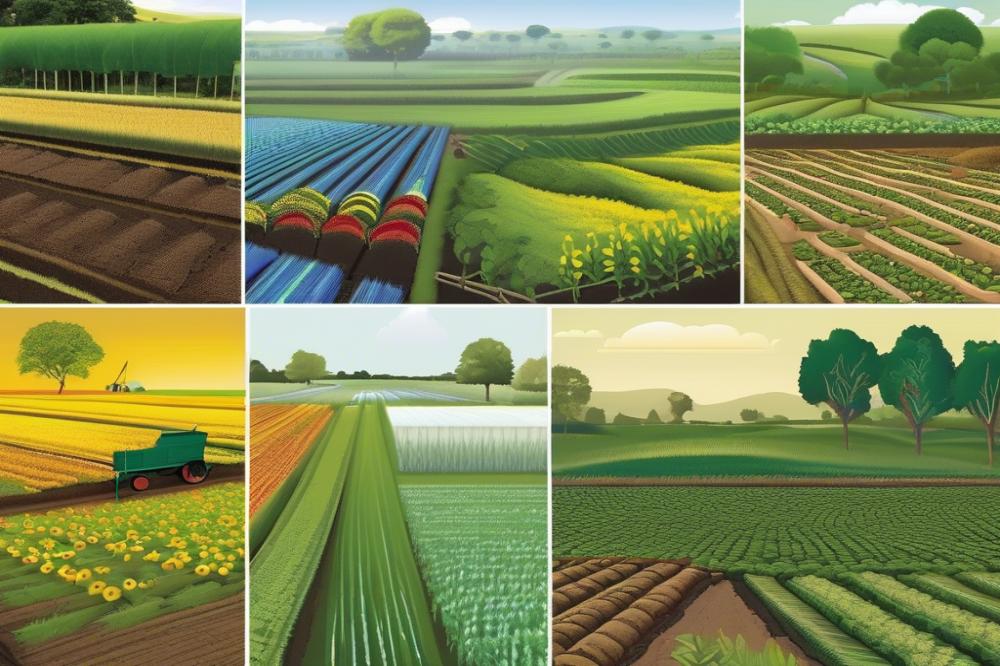Introduction
fertilizers play a vital role in gardening and agriculture. They enhance soil fertility, promoting healthier plant growth and higher crop yield. These substances can be broadly categorized into natural fertilizers and chemical fertilizers. Over time, the methods used to nourish the soil have transformed dramatically, reflecting advances in science and changing farming practices.
Understanding the history of fertilizers is essential for appreciating their importance today. From ancient practices, where composting and manure were common, to modern innovations that include synthetic options, the evolution is remarkable. Each stage has contributed to a deeper knowledge of soil health and nutrient management.
Techniques in fertilization have developed significantly through the ages. Early farmers recognized the need for nutrients, leading to practices such as nitrogen fixation, which enhances soil quality. Today’s organic farming methods emphasize the use of natural ingredients to maintain a balanced ecosystem, often avoiding harmful chemicals.
An ever-growing focus on sustainable agriculture has emerged in recent decades. This has spurred a resurgence in interest for natural substances and holistic practices that support the environment. By knowing the various approaches and their development, gardeners can make informed choices that benefit both their plants and the planet.
The Origins of Fertilizers


natural fertilizers and their early usage
For centuries, farmers relied on natural materials to enrich the soil. Early civilizations quickly discovered that certain organic matter could enhance soil health. These early quantities included animal manures and plant residues. Manure provided essential nutrients like nitrogen, phosphorus, and potassium. Ancient societies such as the Egyptians and Babylonians utilized these resources effectively. They created a foundation for what would later evolve into various fertilization techniques.
Animal manures and plant residues as early fertilization methods
Animal manures were especially popular. Farmers gathered dung from cattle, sheep, and horses, as these livestock produced nutrient-rich waste. Mixing this animal waste with crop residues further increased its effectiveness. This blend contributed to improved crop yield, which was critical for society’s sustainability. Plant residues also played a crucial role. Decaying plant matter returned important nutrients back to the soil. As these practices were refined, they formed an essential part of early agriculture.
Indigenous practices and traditional gardening techniques
Many indigenous cultures had a deep understanding of their local ecosystems. They often practiced methods that involved crop rotation and companion planting. These techniques enhanced soil quality and reduced pests naturally. For instance, planting legumes would promote nitrogen fixation, benefiting subsequent crops. Traditional gardening methods focused on maintaining a balanced ecosystem. This approach demonstrated a profound wisdom that aligned with sustainable agriculture. Farmers worldwide have historically used these principles, creating a connection between nature and cultivation.
The Evolution of Fertilization Techniques


Development of Compound Fertilizers from Natural Sources
People have used natural fertilizers for centuries. Early farmers understood the importance of nutrients for plant growth. They often turned to manure, bone meal, and compost, which they recognized helped soil health. Plant materials also played a crucial role. Ashes from burnt plants added potassium, while crushed shells provided calcium. Over time, these natural components formed the basis of more complex mixtures. As agriculture evolved, farmers began combining these sources for better results. The introduction of crop rotation further enhanced the process, allowing for the replenishment of soil nutrients naturally. This combination of techniques laid the groundwork for what we know today as compound fertilizers.
Introduction of chemical fertilizers in Agriculture
The 19th century marked a significant shift in fertilization methods. Scientists began studying soil needs more closely. Their findings led to the development of chemical fertilizers, which provided specific nutrients in concentrated forms. Unlike natural products, these chemicals could be tailored to meet the precise requirements of various crops. The ability to manufacture fertilizers synthetically transformed agriculture. Farmers could achieve higher crop yield more efficiently and effectively. This innovation brought on a new era, significantly impacting food production worldwide. However, reliance on chemical fertilizers prompted discussions about their effects on the environment and soil long-term.
Impact of Industrialization on Fertilizer Production
With the rise of industrialization came substantial changes to farming and fertilizer production. Factories enabled mass production of chemical fertilizers, significantly lowering costs. This accessibility made it easier for farmers to obtain the products needed for sustenance. The process of nitrogen fixation became a key focus. Large-scale methods allowed for the extraction of nitrogen from the atmosphere, making fertilizers more effective. Although crop yield increased, concerns about sustainability emerged. The push for organic farming gained momentum as people recognized the drawbacks of chemical dependency. Many sought to balance productivity with environmental care. As a result, modern innovations aim to integrate traditional practices with new technology. The history of fertilizers continues to unfold, showcasing the ongoing interplay between nature and science.
The Role of Nitrogen Fixation


Understanding nitrogen fixation and its significance
Nitrogen fixation is a crucial process that allows certain plants to convert atmospheric nitrogen into forms usable by other living organisms. This element is essential for plant growth. A lack of nitrogen can lead to poor soil health and lower crop yield. Farmers and gardeners long identified how vital this process is for sustainable agriculture. By harnessing nitrogen fixation, they can reduce dependence on chemical fertilizers, promoting a healthier ecosystem.
Historic methods of enhancing soil nitrogen
Throughout history, various techniques have emerged to enhance soil nitrogen levels. Ancient civilizations employed composting, using animal manure as a natural source of nutrients. Rotating crops was another method; different plants have varying nitrogen needs and contributions. Over time, these practices evolved, with farmers beginning to understand the role of cover crops. Using specific plants to enrich the soil helped them achieve better harvests without relying solely on synthetic products.
Contributions of legumes and symbiotic bacteria in gardening
Leguminous plants play a unique role in gardening. They are capable of fixing atmospheric nitrogen thanks to a partnership with symbiotic bacteria. These bacteria inhabit root nodules and convert nitrogen into a form that plants can absorb. This natural fertilizer boosts soil fertility while enhancing crop yields. Moreover, when legumes are used in crop rotation or intercropping, their benefits extend to surrounding plants. Understanding these relationships has greatly influenced organic farming practices, enabling gardeners to cultivate thriving ecosystems.
The Rise of Organic Farming


Transition from Chemical to Organic Fertilizers
A significant shift has occurred in agriculture over recent decades. Farmers began to realize the negative effects of chemical fertilizers on the environment. Concerns about soil degradation and water pollution led many to seek alternatives. Organic farming emerged as a popular solution to these issues. This method emphasizes the use of natural fertilizers instead of synthetic ones. In the quest for sustainability, practices evolved that prioritize eco-friendly approaches in crop production.
Benefits of Organic Fertilizers for Soil Health and Crop Yield
Using organic fertilizers contributes positively to soil health. These natural materials help maintain robust microbial activity in the soil. As a result, nutrient cycling becomes more efficient. Crops grown with organic amendments often exhibit improved resilience to pests and diseases. Furthermore, organic practices can lead to enhanced crop yield over time due to better soil structure and fertility. Healthy soil also captures more moisture, which is vital during dry seasons. Many farmers are discovering that a commitment to sustainable agriculture can bring long-lasting benefits.
Popular Natural Fertilizers and Their Uses in Home Gardening
Home gardeners often turn to various natural fertilizers to boost plant growth. Compost is one of the most popular choices. It enriches the soil while improving its texture. Manure, another common option, provides essential nutrients like nitrogen. Fish emulsion serves as a liquid alternative that promotes strong growth. Bone meal is favored for its high phosphorus content, which supports flowering and root development. Kelp extract is also beneficial, containing trace minerals that aid in plant health. Implementing these natural practices offers gardeners an effective approach to nurturing their plants without relying on harsh chemicals.
Sustainable Agriculture and Modern Innovations
Advancements in fertilizer technology have greatly improved sustainable agriculture practices over the years. These innovations focus on reducing environmental impact while maximizing crop yield. Slow-release and controlled-release fertilizers represent a significant step forward. They slowly supply nutrients to plants, matching their growth needs. This method improves soil health by preventing nutrient runoff and promoting efficient uptake.
The emergence of biostimulants has also changed modern gardening methods. These substances encourage plant growth and enhance nutrient uptake without the reliance on traditional chemical fertilizers. The inclusion of microbial solutions plays a vital role in this transformation. Beneficial microorganisms boost soil fertility through processes like nitrogen fixation. This approach greatly benefits organic farming by reducing dependency on synthetic inputs.
Research continues to enhance fertilization techniques for better agricultural productivity. New methods focus on creating a balance between natural fertilizers and chemical options. Farmers are exploring how to integrate these elements effectively. The goal is to reduce costs while maintaining healthy crops. Evidence suggests that biostimulants can lead to healthier plants and ultimately higher production rates.
Innovations in technology also contribute to precision agriculture. This involves using data to apply nutrients more efficiently in relation to specific plant needs. Drones and sensors are becoming commonplace on farms, providing real-time information. These tools help farmers apply the right amount of resources at the right times. As a result, both soil health and crop yield improve without unnecessary waste.
Sustainable agriculture is now more accessible due to these modern advancements. By emphasizing on both the quality of the products and the methods used, farmers can ensure the longevity of the land. Making smart choices about fertilizers supports an overall healthier ecosystem. This commitment to sustainability reflects a growing awareness among producers and consumers alike. As we look ahead, the innovations in agricultural practices promise exciting opportunities for future generations.
Current Fertilization Best Practices
Effective Fertilization Techniques for Home Gardens
Home gardens require careful attention to nutrient management. Successful growth depends on understanding the needs of various plants. A mixture of natural fertilizers and chemical fertilizers can be beneficial. For instance, compost improves soil structure while providing essential nutrients. Consider using a balanced fertilizer when planting vegetables. This can boost early growth and lead to a bountiful harvest. Regular soil testing is crucial. It helps identify nutrient deficiencies and pH levels.
Balancing Nutrient Requirements and Soil Health
Healthy soil is the foundation of fruitful gardening. It’s important to balance nitrogen, phosphorus, and potassium in the soil. Each plant has different nutrient needs. For leafy greens, a nitrogen-rich fertilizer can enhance growth. Flowering plants often benefit from phosphorus to support blooming. The practice of crop rotation can help maintain soil health and reduce disease. Adding organic matter like manure or mulch supplies vital nutrients. Consistent watering and mulching reduces nutrient leaching, preserving what your plants need.
Choosing the Right Type of Fertilizers for Different Plants
Selecting the appropriate fertilizers is key for optimal growth. Understanding the specific requirements of your plants greatly enhances crop yield. Some plants thrive with organic methods, aligning with sustainable agriculture principles. Alternatives to chemical fertilizers exist, and many gardeners prefer these for health and environmental reasons. For instance, using bone meal provides a slow-release phosphorus source for root development. When considering nitrogen fixation, legumes can enrich the soil naturally. Learning about the history of fertilizers helps inform better choices today.
The Significance of Understanding the History of Fertilizers
Grasping the evolution of fertilizers from primitive times to today’s advanced solutions reveals much about our agriculture. Early methods, like using animal manure and compost, laid the groundwork for healthier soils and better crops. As civilizations advanced, so did the techniques for enhancing growth. Chemical fertilizers emerged as a crucial tool, providing concentrated nutrients to meet the demands of modern farming. However, these innovations also brought challenges, particularly regarding environmental sustainability.
Future Trends in Gardening and Sustainable Fertilization Practices
Looking ahead, trends in gardening hint at a growing preference for natural fertilizers. Many gardeners are now turning back to organic practices and sustainable methods. This shift promotes biodiversity and enhances soil health. Technological advancements can also play a role in future fertilization techniques. Innovations could lead to the development of smarter products, perhaps employing sensors to optimize nutrient application. Climate change will influence these advancements, pushing gardeners to find effective ways to maintain productivity while protecting ecosystems.
Encouraging Responsible Use of Fertilizers for a Healthier Garden and Planet
Respecting the environment is vital in gardening and agriculture. Using any form of nutrients wisely can result in a positive impact. Proper education about the benefits of both natural and chemical fertilizers helps gardeners make informed decisions. Responsible application avoids runoff and reduces pollution in our waterways. Ultimately, a balanced approach can support healthy plants while preserving the planet. By fostering awareness and encouraging sustainable practices, we can cultivate gardens that flourish with vitality and minimize ecological footprints.



